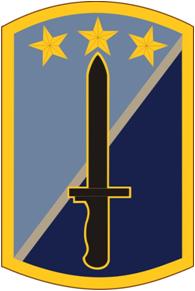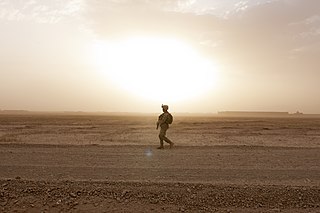The Afghan Armed Forces were the military forces of the Islamic Republic of Afghanistan. They consisted of the Afghan National Army and the Afghan Air Force. Being a landlocked country, Afghanistan did not have a navy. The President of Afghanistan was the Commander-in-Chief of the Afghan Armed Forces, who were administratively controlled through the Ministry of Defense. The National Military Command Center in Kabul served as the headquarters. According to Global Firepower, the Afghan Armed Forces were ranked as the 75th most powerful military in the world. Their total manpower was 186,000 soldiers and officers. They had major bases and small outposts all across Afghanistan, including in the provinces of Badakhshan, Balkh, Helmand, Herat, Kabul, Kandahar, Nangarhar and Parwan, as well as in the cities of Kunduz, Ghazni, Gardez, Khost, Fayzabad, Farah and Zaranj.

The Netherlands Armed Forces are the military services of the Kingdom of the Netherlands. The core of the armed forces consists of the four service branches: the Royal Netherlands Navy, the Royal Netherlands Army, the Royal Netherlands Air Force and the Royal Netherlands Marechaussee. The service branches are supplemented by various joint support organisations. In addition, local conscript forces exist on the Dutch Caribbean islands of Aruba (AruMil) and Curaçao (CurMil). These operate under the auspices of the Royal Netherlands Navy and the Netherlands Marine Corps. The armed forces are organisationally part of the Ministry of Defence.

The International Security Assistance Force (ISAF) was a NATO-led military mission in Afghanistan, established by the United Nations Security Council in December 2001 by Resolution 1386, as envisaged by the Bonn Agreement. Its main purpose was to train the Afghan National Security Forces (ANSF) and assist Afghanistan in rebuilding key government institutions, but was also engaged in the War in Afghanistan (2001–present) against the Taliban insurgency.

The 36th Infantry Division ("Arrowhead"), also known as the "Panther Division", "Lone Star Division", "The Texas Army", or the "T-patchers", is an infantry division of the United States Army and part of the Texas Army National Guard. It was organized during World War I from units of the Texas and Oklahoma National Guard. It was reactivated for service for World War II 25 November 1940, was sent to the European Theater of Operations in April 1943, and returned to the Texas Army National Guard in December 1945.

The Afghan National Army was the land warfare branch of the Afghan Armed Forces. The Afghan Army’s roots can be traced back to the early 18th century when the Hotak dynasty was established in Kandahar followed by Ahmad Shah Durrani's rise to power. It was reorganized in 1880 during Emir Abdur Rahman Khan's reign. Afghanistan remained neutral during the First and Second World Wars. From the 1960s to the early 1990s, the Afghan Army was equipped by the Soviet Union.
The 055 Brigade was a guerrilla organization sponsored and trained by Al Qaeda that was integrated into the Taliban army between 1995 and 2001.

The United States invasion of Afghanistan occurred after the September 11 attacks in late 2001 and was supported by close US allies which had officially begun the War on Terror. The conflict is also known as the US war in Afghanistan or the 2001 invasion of Afghanistan. Its public aims were to dismantle al-Qaeda and deny it a safe base of operations in Afghanistan by removing the Taliban from power. The United Kingdom was a key ally of the United States, offering support for military action from the start of preparations for the invasion. It followed the Afghan Civil War's 1996–2001 phase between the Taliban and the Northern Alliance groups, although the Taliban controlled 90% of the country by 2001. The US invasion of Afghanistan became the first phase of the War in Afghanistan (2001–present).

Law enforcement in Afghanistan is one of three major components of the nation's criminal justice system, along with courts and corrections. The National Directorate of Security (NDS) is the intelligence agency of the government of Afghanistan. The Afghan National Police, which includes the Afghan Border Police and the Afghan National Civil Order Police, is the police force of Afghanistan with jurisdiction that covers the entire 34 provinces of the country.

Below is the disposition and structure of international military forces that were participating in the War in Afghanistan in November 2012, listing deployed units under the command of the International Security Assistance Force (ISAF), which controlled both combat and reconstruction operations. During its existence from 2001 to 2014, ISAF comprised units from many countries. In this article, units are assumed to be from the United States unless otherwise stated. This list is a rough and unofficial listing of units and formations.

This article covers the Afghan history between the Taliban's conquest of Kabul and their establishing of the Islamic Emirate of Afghanistan on 27 September 1996, and the U.S. and U.K. invasion of Afghanistan on 7 October 2001: a period that was part of the Afghan civil war that had started in 1989, and also part of the war in Afghanistan that had started in 1978.

Following the terrorist attacks of September 11, 2001, several nations took on Al-Qaeda and the Taliban during Operation Enduring Freedom (OEF) in Afghanistan. OEF was the initial combat operations starting on 7 October 2001, in the wake of the 11 September attacks on the United States, and during 2002 and 2003.

The Afghan National Police was the national police force of the former Islamic Republic of Afghanistan, serving as a single law enforcement agency all across the country. The agency was under the responsibility of Afghanistan's Ministry of Interior Affairs, headed by Hayatullah Hayat. The ANP had 116,000 members in December 2018.

The 170th Infantry Brigade was an infantry formation of the United States Army. From 2009 to 2012, as part of its third period of existence, it was based at Baumholder in the Federal Republic of Germany.

Task Force Phoenix, or more properly known as Combined Joint Task Force Phoenix, was an international military formation. It was organized by the United States Central Command (CENTCOM) in 2003-2004 to train and mentor the newly created Afghan National Army/Afghan National Security Forces (ANSF) to establish and maintain law and order throughout Afghanistan using Embedded Training Teams or ETTs.
The Afghan National Security Forces (ANSF), also known as the Afghan National Defense and Security Forces (ANDSF), were the military and internal security forces of the Islamic Republic of Afghanistan.
The NATO Training Mission-Afghanistan (NTM-A) was a multinational military organisation, activated in November 2009, tasked with providing a higher-level training for the Afghan National Army (ANA) and Afghan Air Force (AAF), including defense colleges and academies, as well as being responsible for doctrine development, and training and advising Afghan National Police (ANP). The commanding officers, is dual-hatted and commands both NTM-A and Combined Security Transition Command – Afghanistan (CSTC-A) and reports to Commander ISAF.

The National Islamic Movement of Afghanistan, sometimes called simply Junbish, is a Turkic political party in Afghanistan. Its founder is Marshal Abdul Rashid Dostum.

EUPOL Afghanistan (2007-2016) was a European Union mission supporting the reform efforts of the Afghan government in building a civilian police service in Afghanistan.

Georgia joined the war in Afghanistan in 2004 and the country had become the largest non-NATO and the largest per capita troop contributor to the International Security Assistance Force in Afghanistan by late 2012, with over 1,560 personnel on the ground as of May 2013. At its peak deployment, Georgia provided two full infantry battalions serving with the United States forces in the Helmand province. Since the beginning of their mission, more than 11,000 Georgian soldiers have served in Afghanistan.

The 12th Peacekeeping Brigade is a military unit of the Armed Forces of Armenia. Sometimes referred to as the Blue Berets due to its role, it solely specializes in peacekeeping in foreign countries as part of international initiatives. It is commanded by Major General Artak Tonoyan. In early 2016, Defence Minister Seyran Ohanyan said that he considers the brigade to be the "basis for the establishment of a professional army".















